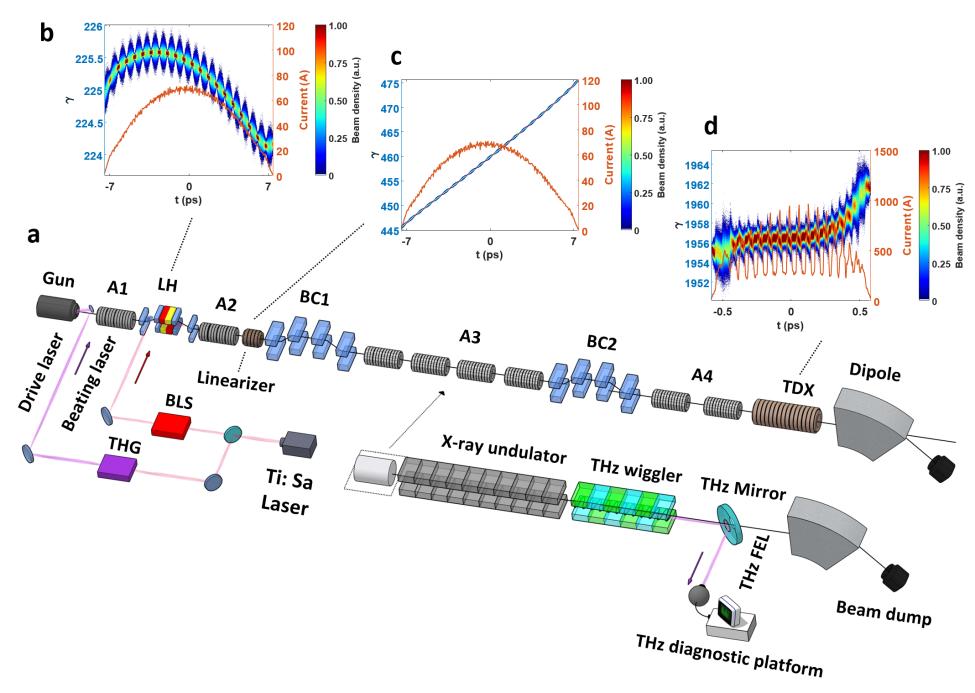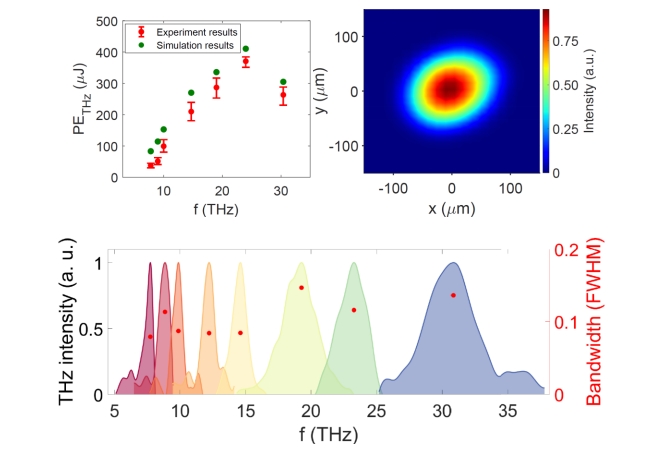Research Progress
In a study published in Nature Photonics, the Free-electron Laser Team of the Shanghai Advanced Research Institute (SARI), Chinese Academy of Sciences developed an innovative approach by employing beating-frequency laser modulation of electron beams to precisely tailor the beam structure and produce continuously tunable THz radiation.
Strong-field terahertz (THz) radiation with continuously tunable frequency plays a vital role in frontier scientific research such as quantum materials, molecular catalysis, and nonlinear optics, as well as in key technological fields including next-generation communications, environmental monitoring and security inspection.
However, existing methods for generating strong-field THz radiation worldwide are mainly limited to the low-frequency range of 0.1–5 THz. Achieving high-intensity, continuously tunable THz radiation in the 5–30 THz frequency range has long been a critical technical challenge in this field. Free-electron lasers (FELs), as advanced light sources capable of producing continuously tunable, high-power THz radiation, offer a promising solution to this challenge. Only a few FEL facilities worldwide can currently produce continuously tunable THz radiation, and most rely on bunch-compression schemes.
These approaches suffer from limited frequency tuning range and relatively low radiation pulse energy, making them inadequate for the demanding requirements of cutting-edge scientific research and industrial applications.

Figure 1 SXFEL layout and the experimental schematic (Image by SARI)
To overcome the challenge of generating continuously tunable strong-field THz radiation in the 5–30 THz range, researchers introduced a novel free-electron laser (FEL) approach that intrinsically covers the entire THz gap. The technique pre-modulates a relativistic electron beam with a frequency-beating laser pulse, then leverages bunch compression along with collective effects to enhance the THz microbunching.
Relying on the Shanghai Soft X-ray Free-Electron Laser (SXFEL) facility in China, the research team has, for the first time, experimentally demonstrated the feasibility of this method. They successfully realized continuously tunable THz radiation covering 7–30 THz (wavelengths of approximately 10–40 μm) with the highest peak brightness ever achieved through this frequency range.

Figure 2 The measured pulse energies, light spot (19 THz) and spectra (Image by SARI)
The THz source delivers a pulse energy up to 400 μJ, pulse-to-pulse energy stability (RMS) better than 10%, and pulse duration tunable between 300 fs and 3 ps, with a maximum repetition rate of 50 Hz. By integrating this method with superconducting continuous-wave accelerator technology, the repetition rate could be further increased to the megahertz (MHz) level.
Developing strong-field THz sources based on high-gain X-ray FEL facilities holds great potential for advancing THz pump–X-ray probe techniques. This achievement significantly extends the performance boundaries of strong-field THz sources and establishes a solid foundation for their broad applications in frontier scientific research and advanced technological developments.
This research was supported by the National Natural Science Foundation of China, the SARI Innovation Fund (Fostering Program), Shanghai Municipal science and Technology Major Project, and CAS Project for Young Scientists in Basic Research.





